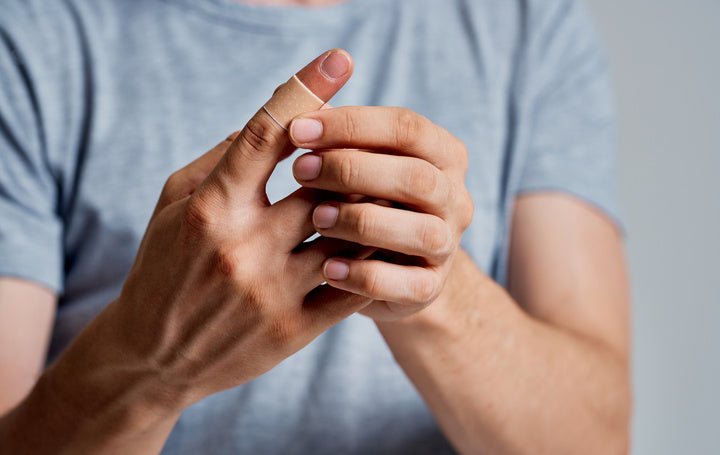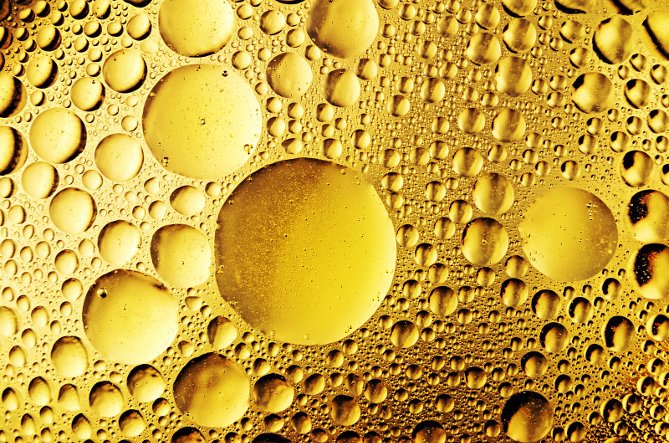It’s really no secret how fascinating the human body is. It carries us through life, bending and molding as we push it to its limits. And it’s constantly restoring itself through wound healing, which is an intricate process that’s often taken for granted. Ever wondered how the skin heals itself? Think back to being a child: How did you care for wounds? Most likely, you slapped on a bandage and called it a day. Yet – under that bandage – your body orchestrated a complex cascade of step designs to heal wounds no matter their size or degree of seriousness.
So – Can your body heal itself from anything? What helps your skin heal? Can you heal your skin from within? To answer those questions and more, here’s the scoop on how the skin heals itself:
How the Skin Heals Itself With the Four Stages of Wound Healing
The definition of wound healing is pretty self-explanatory (AKA it's how the skin heals itself after an injury), but it goes a bit deeper than that. When your skin is healing itself, its main aim is to prevent more damage from happening, while cleaning and sealing the wound to help restore tissue strength. To do this, your skin has to go through a rigorous healing process that includes four intricate stages.
Here’s an in-depth look at how the skin heals itself:
How the Skin Heals Itself: The Homoeostasis Phase
In science class, did you ever hear of something called homeostasis? Maintaining homeostasis is the first stage of how your skin heals itself. In short, the main purpose behind homeostasis is balance; it works to maintain your body’s stability, while also helping it adjust to conditions that are optimal for survival. You may see the remnants of homeostasis as a blood clot.
The Science: Homeostasis is the process of your wound being closed by clotting. Homeostasis starts when blood leaks out of your body, but the first step of homeostasis is when blood vessels work to restrict blood flow. Next, blood platelets stick together to seal off the wound. Finally, coagulation occurs and reinforces the wound with threads of fibrin (a binding agent).

Pictured: Homeostasis Phase | Source: Diller Law
How the Skin Heals Itself: The Inflammatory Phase
As the second stage of how the skin heals itself, getting bleeding under control while preventing infection is the top priority. During the inflammatory phase, damaged cells and harmful bacteria are zapped from the wound site. Swelling, heat, pain, and/or redness may be seen during this stage, which is completely normal and only problematic if prolonged.
The Science: The inflammation phase begins when your damaged blood vessels leak transudate (a clear fluid made of water, salt, and protein) to kickstart swelling. White blood cells, known as macrophages, protect the wound by fighting infection and overseeing the repair process. They also make chemical messengers (growth factors) which help repair the wound.

Pictured: Inflammatory Phase | Source: Diller Law
How the Skin Heals Itself: The Proliferative Phase
The proliferative phase (the third phase in how the skin heals itself) is all about rebuilding what was damaged. During this stage, the wound shrinks to rebuild severed tissues. Sometimes, your skin creates a whole new network of blood vessels to supply the wound with a good amount of oxygen and nutrients. If your wound is pink and/or red and uneven in texture, it's healthy! You should see your doc if it’s darker in color.
The Science: During the proliferative phase, your wound is rebuilt with new tissue that’s made of collagen and extracellular matrix, which aids in cell growth. Myofibroblasts (found in scar tissue) cause the wound to shrink by gripping the edges and pulling them together. Often, you can see the result of the proliferative phase as a scar.

Pictured: Proliferative Phase | Source: Diller Law
How the Skin Heals Itself: The Remodeling Phase
As the final stage in how the skin heals itself, it gets prepared to take on a new, remodeled style. To do this, everything has to go back to normal: Your skin returns to its original appearance, cells that were recruited to the wound site are given the boot, and your skin is reinforced to be stronger than ever. During this stage, the wound site may be itchy or even pucker.
The Science: The remodeling stage happens when collagen is made from type III to type I, helping your wound to fully close. Cells that were being used to repair your wound aren’t needed anymore, so they’re removed via apoptosis – or programmed cell death (RIP). Generally, this phase begins around 21 days after your injury.

Pictured: Remodeling Phase | Source: Diller Law
You Can Impact How the Skin Heals Itself
A wound is defined as an injury that breaks, cuts, or impacts the skin in any way. Most minor wounds won’t require a visit to the doc, but there are a few things you can do to speed up and strengthen how the skin heals itself:
Caring for the Wound
Let’s be real: You probably don’t need me to preach to you about why taking care of your wound is important; I’m sure your mother, father, and/or sibling have imparted the tidbit of advice to you that cleaning your wound is always necessary to keep out infection. Even if you feel that you’re healing fine, you should still tend to your wound until the end of the remodeling phase.
Here’s a rundown of how to properly clean your wound to promote healing:

Pictured: Basic Wound Management | Source: Australia-Wide First Aid
Get Some Good-Quality Rest
During the night, your body is doing more than just sleeping – it’s working to repair any damaged tissues while fighting off infections. In fact, one study followed two groups to see how the skin heals itself and if it can be impacted by sleep. It found that those who rested for eight or more hours a night healed faster by a full day.

Pictured: How the Skin Heals Itself While You Sleep | Source: Dermalogica
Be Food-Aware
If you’re already a protein junkie – you’re in luck. Eating protein-rich foods can promote how the skin heals itself. Good sources of protein include lean meats, poultry, fish, tofu, eggs, legumes, and nuts. Olive oil and vitamin C-rich foods are also great options as they have anti-inflammatory and antioxidant properties, which promotes how the skin heals itself.
However, there are also some foods and drinks that you should take off your grocery list. For example, drinking certain types of alcohol can increase inflammation (AKA it may stop or harm the healing process). Try limiting sugar and refined grains as they can also cause inflammation. In addition, processed foods are a no-go; they often contain chemicals, dyes, and other additives that can slow how the skin heals itself.

Pictured: Foods to Choose for Skin Healing
Do Some Physical Activity
Exercise is always the answer. In fact, research has shown that physical activity is able to accelerate how the skin heals itself by as much as 25%. If you’re worried about aggravating your wound while sweating at the gym, try a low-impact activity as they’re able to help draw oxygen to your wound for optimal healing.

Pictured: Low-Intensity vs. High-Intensity Work Outs | Source: Forth
How the Skin Heals Itself With Ingredients in Skincare
Much like food, there are skincare ingredients that can amplify how the skin heals itself. Here are a few to keep an eye out for:
- Safflower: With Safflower’s antioxidant properties, it can ensure a good level of wound hydration by providing an insulating barrier between the outside environment and your wound.
- Squalane: Studies have shown that Squalane is able to promote wound healing by suppressing inflammation and initiating wound repair. It’s often recommended to use products with Squalane during the inflammatory stage.
- Jojoba Oil: It’s been documented that Jojoba Oil can accelerate wound healing by helping your skin make more collagen, which provides structure, strength, and support throughout your body and skin.
- Vitamin C: Also known as ascorbic acid (AA), Vitamin C is involved in all four phases of how your skin heals itself. In the proliferative phase, for example, Vitamin C contributes to the creation and secretion of collagen.
- Vitamin E: As an antioxidant, Vitamin E plays an important role in reducing inflammation and increasing collagen production. Vitamin E is one of the major antioxidants present in the skin and is commonly used topically to treat wounds and scars.
- Vitamin K2: Sometimes referred to as Menaquinone, Vitamin K2 is invaluable for blood clotting. It’s also an important vitamin for your skin as it helps heal wounds, bruises, and abrasions.
The MOX Daily Face Care Kit Was Formulated to Reinforce and Maximize How the Skin Heals Itself

The nutritionist and pharmacist-formulated MOX Daily Face Care Kit – which includes the Invigorating Peppermint Cleanser and Multi Nutrient Serum – were created to reinforce and maximize how the skin heals itself with good-for-you nutritional ingredients like the ones mentioned above. MOX’s formulator, Pharmacist Ben Fuchs, breaks it down:
“I was privy to the medicinal powers of vitamins and nutrients. And so, because the skin is turning over at a faster rate than any other tissue in the body, it’s very receptive to nutrition. I discovered this thirty-five years ago. And honestly – still to this day, I can’t figure out why other brands aren’t using this simple skin science.”

To promote wound healing and stronger skin, grab the lipid-rich MOX Daily Face Care Kit. After all, your skin works incredibly hard, so it deserves powerful, nutrient-rich fuel to keep it healthy 24/7.
Did you know about how the skin heals itself? Let us know in the comments!
References:
- https://www.ncbi.nlm.nih.gov/pmc/articles/PMC7661123/
- https://pubmed.ncbi.nlm.nih.gov/30363968
- https://www.jojobadesert.com/press_releases/the-healing-power-of-jojoba-oil/
- https://www.ncbi.nlm.nih.gov/pmc/articles/PMC7949787/
- https://www.ncbi.nlm.nih.gov/pmc/articles/PMC6533928/
- https://ufhealth.org/skin-and-wound-healing
- https://www.hopkinsmedicine.org/health/treatment-tests-and-therapies/how-wounds-heal




Leave a comment
This site is protected by hCaptcha and the hCaptcha Privacy Policy and Terms of Service apply.